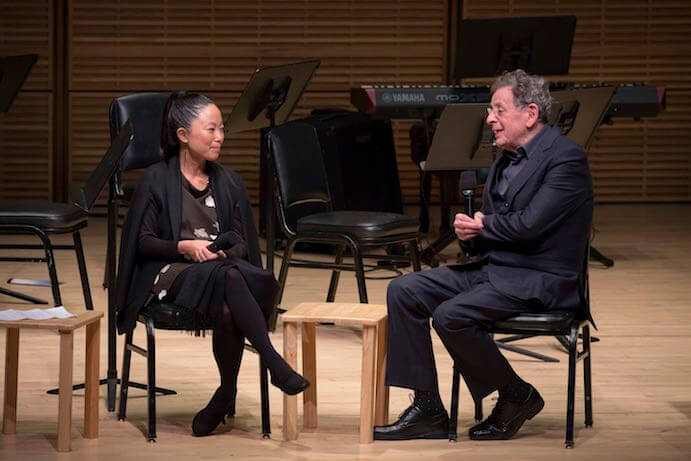Shimmering columns of light danced up the wall of Zankel Hall on the evening of December 8, 2017, and the American Composers Orchestra came to life with cool, nearly-static soft tones for the world premiere of Pauchi Sasaki’s GAMA XVI. A video projection streamed upward, drifting light onto the wall behind the orchestra and conductor George Manahan and lifting attention up into the panoramic speaker system that studs Zankel Hall’s ceiling. Slowly, almost imperceptibly, a tumbling chorus of electronic sounds drifted through the hall, and Pauchi Sasaki appeared. She entered from a back entrance amid the audience, lit with a beam of from her own flashlight held high above her head and wearing an armor-like dress thatched together from one hundred small audio speakers. As Sasaki processed slowly down the aisles, her active, gestural electronic sounds meshed with the lushly stacked harmonies of the orchestra. The Speaker Dress is a central piece in the Peruvian composer-performer’s practice, representing years of development and performance with this sounding skin that responds to and amplifies her movement. She has said, “I always wondered about how it would feel to become sound. When I started the Speaker Dress project, my main goal was to achieve a visual manifestation of sound and to create a facilitator for sound embodiment.”
Jittering sounds enlivened the room as Sasaki moved through the hall towards the stage, where the orchestra and lights still flickered upwards. She ducked out a side door and reappeared onstage, virtuosically moving her arms to control her motion-sensitive solo part. Sasaki’s physical approach to her instrument is oracular and vivid, her processional pace through the hall and her soloistic poise onstage augmented by sweeping gestures from her arms that trigger a brushy, vocalistic polyphony from the interwoven speakers. In the third stage of the continuous piece, violinist Tim Fain entered from backstage and weaved in and out of the ensemble sound with sometimes soaring, sometimes textural violin lines. Fain and Sasaki were twin soloists, spaced across the front of the stage. While Fain’s amplified violin sound was quite strong in the mix above the orchestra, Sasaki’s speaker dress was buried in the texture at times; I found myself longing to hear more of her varied and inventive sounds in the balance.
Pauchi Sasaki and the American Composers Orchestra–Photo by Jennifer Taylor
Sasaki has been the 2017 Rolex Protégé for the Rolex Mentor and Protégé Arts Initiative, and the program with the American Composers Orchestra reflected the central value of the initiative: facilitating the development of close creative and collaborative relationships between emerging and established artists. Bryce Dessner’s Réponse Lutosławski, the second piece on the program, also reflected the central theme. The piece was written in 2014 as a result of the composer’s deep and immersive study of Witold Lutosławski’s 1958 Musique funèbre for string orchestra. Each of its five movements is inspired by the score, and the influence is audible in Dessner’s complex interlocking orchestral writing. The American Composers Orchestra played well in this New York premiere, with excellent blend and admirable control across the orchestra.
Philip Glass, who served as the Rolex Mentor to Pauchi Sasaki, also wrote an homage to an inspiring composer. Glass’s second violin concerto, titled The American Four Seasons, was written in oblique homage to Vivaldi’s Four Seasons. Though the colorful stage lighting hinted at a season assigned to each of the four movements, the composer indicated that the references to the seasons are intentionally obscure: Glass writes, “There will be no instructions for the audience, no clues as to where Spring, Summer, Winter, and Fall might appear in the concerto—an interesting, though not worrisome, problem for the listener.” Tim Fain’s interpretation was mature, lyrical, sparkling. A seasoned performer of Glass’ violin works, Fain truly shined during the unaccompanied Interludes, a Prologue, and three Songs composed to serve as both cadenzas and as stand-alone pieces.
Tim Fain with the American Composers Orchestra–Photo by Jennifer Taylor
The evening concluded with a conversation between Glass and Sasaki—Mentor and Protégé—moderated by American Composers Orchestra President Edward Yim. The conversation between them illuminated the composers’ shared interests and the friendship that has developed between them through the year, highlighting their similar passions for film scoring and visuality, mutual disillusionment with the potential stifling of compositional creativity in academic programs, and their incorporation of their unique areas of expertise in both Western and non-Western musical traditions. Glass also had a few moments to share stories about his own mentors during his musical education in Paris: Hindustani composer and performer Ravi Shankar and Parisian composer and tutor extraordinaire Nadia Boulanger. Both in music and in conversation, the evening’s themes of mentorship, inspiration, and relationship-building created an inspiring picture of what it means to belong to a musical lineage that unshakably pursues both excellence and individuality.

